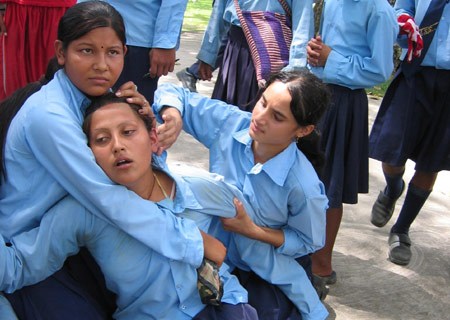A new study published in Frontiers in Psychiatry explores the factors associated with Mass Psychogenic Illness (MPI) among school-going adolescents in Nepal. Mass Psychogenic Illness, often known as mass hysteria, is when there is a sudden and rapid spread of symptoms among a group of people. It is considered psychological in origin given the absence of a physical cause.
The research was conducted by Ram Sapkota, Alain Brunet, and Laurence Kirmayer of McGill University. The authors found that factors such as hypnotizability along with peritraumatic dissociation predicted MPI most reliably. The latter refers to a person dissociating (numbing, depersonalization) in the face of a traumatic event.
MPI symptoms can range from trance states to abdominal pain, even fits and hyperventilation—people’s experiences, and the process of spread is different across communities. Two common forms of MPI are trance and possession states (by spirits and deities), especially in Nepal. Numerous cultures across the world and through history have spoken of spirit and deity possessions.
Some researchers, including Kirmayer, a co-author in this study, have pointed to their place in indigenous healing traditions. In Western psychiatry and psychology, many of these phenomena are explained using psychological dissociation and social contagion models.

Psychology’s WEIRD problem, where most of the studies are on Western, Educated, Industrialized, Rich, and Democratic countries, has plagued the field for decades. Thus, studies conducted in non-WEIRD nations like Nepal are essential to developing a better understanding of human experience and distress. These often end up challenging psychiatry’s fundamental ideas about abnormality.
Since the late 1990s, Nepal has reported many cases of chhopne, the mass spread of involuntary dissociative trance or possession states. Over 130 schools have reported these cases, which often include “multiple children in the classroom or schoolyard falling to the ground writhing, moaning, shouting and crying for periods of minutes to hours.”
The authors write that previous studies in Nepal have linked MPIs to trauma, low socioeconomic status, exposure to violence, and anxiety. Qualitative data reveals that MPI is not a mental illness as much as an “avenue to cope with and communicate distress associated with existing psychosocial problems.”
The authors aimed to find the causes and other correlated factors of MPIs by comparing MPI cases and controls (no MPIs). They categorized various explanations and predictive factors that could be related to MPIs into four types: childhood trauma, cognitive and personality traits (hypnotizability, fantasy proneness, etc.), current distress (depression, PTSD, etc.), overall tendency to dissociate, and peritraumatic dissociation (dissociation during the traumatic event).
While many of the symptoms displayed by the children are similar to what the DSM-V and ICD-11 categorize as dissociative disorders, the authors assertively clarify that they do not think these experiences are pathologies in the individual. Rather, they study which dissociative factors are correlated with chhopne because there might parallel mechanisms, shaped by cultural contexts, underlying both these phenomena.
A case-controlled study was conducted with 194 children who had experienced MPIs in schools and 190 controls. The children were between 11 to 18 years of age, did not have epilepsy or other severe disorders (self-reported), and had recently had a chhopne episode. Children in the control group were demographically similar (similar age, ethnicity, gender, socio-economic status) and were often friends or classmates of the child who experienced MPI. They themselves had never had this experience.
No statistically significant differences were found between MPI cases and control children based on demographics. At the same time, there was a 1.5 times higher chance of having an MPI if the child was from a nuclear family instead of a united/extended family. The authors write that a shift from united to nuclear families, which is an increasing trend in Nepal, might lead to fewer resources and lower social and emotional support. Earlier studies have shown these factors associated with dissociative experiences and living in Nepal in nuclear families to be linked with psychosocial problems.
While a simple binary regression analysis showed a positive relationship between depressive symptoms and post-traumatic stress with MPIs, a more complex multivariable logistic regression analysis showed no significant relationship. Contrary to what is commonly found in the literature on MPIs, this study did not find any predictive relationship between current distress (depression and PTSD) and MPIs.
Thus, it was unclear whether these trance and possession experiences pointed to a mental disorder or not, especially given that the distress rates even in the control group were high. These results are important because there is a tendency to pathologize these states even when they happen in radically different contexts and carry very different meanings for the people who are having them. Indigenous psychologists have for long warned against this premature pathologization.
A regression analysis was conducted to find the predictors of MPIs. Childhood trauma, but only physical abuse, predicted MPIs, and not emotional and physical neglect and emotional and sexual abuse. This analysis also showed a significant relationship between hypnotizability and peritraumatic dissociation with MPIs. Importantly:
“When all the variables in the four models were simultaneously entered into the final multiple logistic regression, no variable showed a significant effect on predicting caseness… The CART analysis suggested that hypnotizability and peritraumatic dissociation were the most important predictors of caseness”.
Thus, many of the assumed important variables that have shown up in previous literature, such as fantasy proneness, childhood abuse, post-traumatic stress, had either little or no effect on MPIs in this study. This challenges some older assumptions which state that trance and possession states, often defined by diagnostic manuals as dissociative disorders, have the same underlying variables or mechanisms as these disorders.
The authors write that their study has several limitations. First, the sample was largely female, and only three of the many psychometric instruments used to measure different variables (childhood trauma, dissociation, etc.) were both reliable and valid in Nepal.
Overall, this study finds some results that are contradictory to older literature that relates trance and spirit possessions with dissociative disorders. It is an important contribution in understanding culturally specific experiences on their own terms and not through the language or lens of psychology.
As other researchers have pointed out, it is not important whether a group of people is actually possessed by spirits, if this form of meaning-making helps them deal with distress and is healing, then it is presumptuous for the Western psy-disciplines to interfere.
****
Sapkota, R.P., Brunet, A., & Kirmayer, L.J. (2020). Characteristics of adolescents affected by Mass Psychogenic Illness outbreaks in schools in Nepal: A case-controlled study. Frontiers in Psychiatry, https://doi.org/10.3389/fpsyt.2020.493094 (Link)















If it’s not pathology to fall down and writhe in one country, then it’s not pathology in the other.
Report comment
Ayurdhi:
or Dr. Dhar, which is your preference from the emergent culture of Mad in America and “Mad in America” but perhaps beyond the political borders?
Could you explore the idea of beliefs held? (And while I would like to say belief systems, the very idea of a system has advanced in a way that faciliates learning along with being too easy to codify in terms of open or closed to the detriment of a richer reality that we struggle to understand.
When you write about challenging “psychiatry’s fundamental ideal about normality” the door into the expression being realized visually in the article can be overwhelming in part because of the range of rich beliefs held with the gods so to speak. If one enters into the vast refereed papers, the stats and correlations, etc. then what, if the emerging situation is being framed in part by the technologies that broadcast the story, but then an understanding for the hi and low of an engineered world driven often by “more” rather than better.
What does the term “mass psychogenic illness” impart to a mind(s) trying to understand a speed of learning by which people are coming to know an evolving culture being challenged? To hold a thought, to release others and still to let go as we work through these experiences suggest to ask the question, if indeed the individuals who travel into these altered states will not eventually emerge as the teachers? Seemingly in a like manner, have been given “a collar” so to speak, that is a labe”, I thought perhaps there might be a way to enter my madness or the experience, with a purpose to come back and attempt to explain what was experienced.
However, the results whether medicated or not along with a way of coping, seemingly has been dismissed, until I began to focus and shift more towards the Arts. I can’t help but think that in framing the study of adolescents, if there if violence in the framing that excluded a question of the adults impacted within and beyond the families. How could one(s) transform the space to sift the meaning, not that something is being learned now? Or in the NOW?
Report comment
“What does the term “mass psychogenic illness” impart to a mind(s) trying to understand a speed of learning by which people are coming to know an evolving culture being challenged?”
Thank you. This is exactly what I was going to address. I can’t help but think that the framing here of illness is an imposition of western cultural values rather than truly being open minded to learning from what another culture understands a behavioral phenomena to mean. We can’t understand until we ask rather than framing our understanding in a medical manner from the start. I think the researchers missed the mark. Anthropology isn’t, or isn’t supposed to be another form of colonization but this is clearly colonization of thought at the very least.
Report comment
Well, I am underwhelmed with the level of intellectual insight brought to this problem by these researchers.
I have recently reviewed some data about this in my materials.
Extraordinary baseline levels of stress in a group is one important factor. This can be brought on by a sudden tragic event but is more likely to occur where a group or a culture is under constant and unrelenting excess stress. In the U.S. for instance we have the mainstream media. It supplies those who choose to tune in with a constant barrage of alarming news, including these days large doses of outright untruth. In another culture it might be a chronic nutritional challenge, environmental pollution, economic hardship, or something else like that.
The next factor is hypnotic level. I would see this as simply reactivity, but I am not an expert. Something will happen, and one person will go “over the edge” so to speak and react first. Then others will follow in a kind of chain reaction, just copying the first one.
There is some small suggestion here that reacting and “getting it our of your system” might be therapeutic. The study seemed to make a point that these episodes should not be seen as pathology and, we assume, do not lead to pathology.
My materials liken it to being exposed to ionizing radiation. You don’t notice it for some time, until you reach some sort of reactive threshold, then suddenly you get very sick. The solution of course is to eliminate the stressor. I don’t know what that would be in Nepal. Here is the U.S. this would probably translate to: Turn off the news!
Report comment